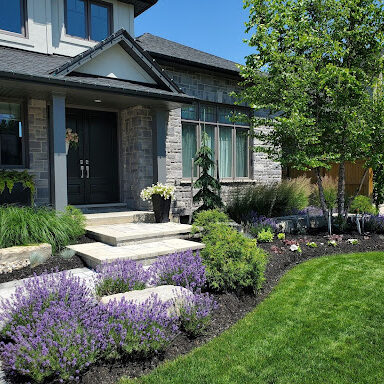Strategically landscaping around your home’s foundation is important as it protects the structure and ensures the safety of your home. When the space that surrounds your foundation isn’t properly protected and maintained, water damage, pest infestations, and unmanageable weed overgrowth can occur, causing unnecessary damage to your home. One of the most popular strategies offering the best results is to landscape from the base of the foundation to ten feet away with a sustainable and protective material.
The best materials for landscaping around the foundation will prevent the growth of weeds, provide efficient water drainage, prevent soil erosion, and deter insects and other pests. Our landscaping experts at Mountview Services can help you determine the best foundation landscaping materials for your home. If your goals are to enhance the appearance of your property and outdoor space while preserving and protecting your home from possible damage, this article is for you.
The Best Landscaping Materials to Protect Foundations
There are many foundation landscaping material options available, providing a variety of aesthetic and functional purposes. Our top recommendations for the best landscaping materials include:
Gravel: Gravel promotes drainage and prevents water from pooling near the structure of your home. We recommend using coarse gravel that encourages drainage and can be installed by applying an even layer that creates a sloped surface, drawing moisture away from the foundation.
Mulch: Organic mulch, such as wood chips or bark mulch, helps to regulate soil temperature and retain moisture. Mulch also effectively reduces soil erosion and inhibits weed growth, preventing the negative effects of water damage and soil movement.
Stones or Pavers: Placing pavers or stones around the foundation creates a strong physical barrier that prevents soil erosion and directs water away from your home. We recommend choosing materials that permit water to drain through them, such as porous concrete pavers or permeable natural stone.
French Drain: A French drain is a small trench filled with gravel or rock to redirect water away from the foundation, effectively eliminating drainage issues and preventing water from seeping into the soil around the foundation.
Rain Gardens: Rain gardens are designed to retain and absorb rainwater runoff from roofs, driveways, and other surfaces, reducing the need for manual watering. By planting native plants and grasses in a rain garden, you will encourage the soil to absorb excess water and reduce the risk of water accumulating near the foundation.
Retaining Walls: Installing a retaining wall to create stepped landscaping around your home’s foundation helps to avoid soil erosion and stabilize any sloping or grading. Choosing durable materials (such as concrete blocks or natural stone) will ensure proper drainage behind the retaining wall and avoid water accumulation.
Raised Flower Beds: Building raised flower beds with landscaping timbers, concrete blocks, or stone retainers creates a physical protective barrier around the foundation. Adding shrubs, flowers, or ground cover plants to your raised beds will promote the absorption of water and prevent soil erosion.
Slope and Grading: The foundation area around your home must be properly graded to create a subtle slope away from your home. This is one of the most important and effective methods of preventing water damage. We advise ensuring the soil slopes away at a minimum gradient of 1 inch per foot for the 6 feet nearest to the foundation.
Before you choose which landscaping material to protect foundations you want to use, factors such as drainage needs, soil type, climate, local regulations, and building codes should be carefully considered. The look you are hoping to achieve and how the materials you choose will fit with the aesthetic of the rest of your outdoor space should also contribute to your decision.
What Shouldn’t You Use to Landscape Around Your Foundation?
While the above options offer protection to the structure of your home, other elements could negatively impact your foundation. It is never recommended to landscape around your foundation using a large tree variety of any kind. Tree varieties such as American elm, Willows, Silver or Norway Maple, Cottonwoods, Poplars, Aspens, Black Locust, and Black Alder should not be planted within 10-15 feet of your home, as their roots can cause damage to your foundation.
Instead, you could consider small evergreen or low-growing shrubs or small ornamental trees, though they should be planted at least 2 feet from the foundation.
Call in the Experts
If you’re still unsure of the best landscaping material for the area around your foundation or simply want the benefit of expert advice, our team at Mountview Services would love to hear from you. Contact us today to learn more about how we can help protect your home’s foundation and create an outdoor space that you love!

